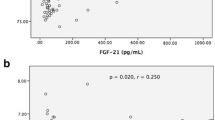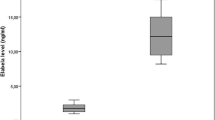Abstract
Introduction
Elevated fibroblast growth factor-21 (FGF-21) levels are related to carotid intima-media thickness (CIMT), a well-established marker of atherosclerosis. Acromegaly has also been linked to increased CIMT. There has been no data considering the association between FGF-21 levels and atherosclerosis in acromegaly patients. This study aimed to evaluate FGF-21 levels and CIMT in acromegalic patients in relation to atherosclerotic complications.
Design
Case–control study.
Materials and methods
The study group included 70 acromegaly patients and 72 healthy volunteers from the Department of Endocrinology and Metabolism Disease, Marmara University Medical School. FGF-21, growth hormone, insulin-like growth factor I, lipids, glucose, insulin levels were assessed. CIMT was measured from the common carotid artery wall on B-mode ultrasound.
Results
Median FGF-21 levels were significantly lower in the acromegaly group than in the control group. CIMT was higher in acromegaly patients compared to controls. Although there was no correlation between FGF-21 levels and CIMT in patients with acromegaly, a positive correlation was found between high-density lipoprotein-cholesterol and FGF-21 levels. Glucose metabolic markers were the determining factors of the FGF-21 levels in acromegaly patients.
Conclusion
Our study is the first to examine the relationship between serum FGF-21 levels and atherosclerosis in acromegaly patients. The lower serum FGF-21 levels in acromegaly subjects might be associated with the improving effects of growth hormone on liver fat. Acromegaly was linked to higher CIMT, but there was no correlation between FGF-21 levels and CIMT. The role of FGF-21 in acromegaly as a marker of atherosclerosis requires additional research.
Similar content being viewed by others
Change history
25 July 2022
A Correction to this paper has been published: https://doi.org/10.1007/s40618-022-01867-7
References
Giustina A, Barkan A, Beckers A, Biermasz N, Biller BMK, Boguszewski C et al (2020) A consensus on the diagnosis and treatment of acromegaly comorbidities: an update. J Clin Endocrinol Metab. https://doi.org/10.1210/clinem/dgz096 (Epub 2019/10/14)
Colao A, Grasso LFS, Giustina A, Melmed S, Chanson P, Pereira AM et al (2019) Acromegaly. Nat Rev Dis Primers 5(1):20. https://doi.org/10.1038/s41572-019-0071-6 (Epub 2019/03/23)
Brevetti G, Marzullo P, Silvestro A, Pivonello R, Oliva G, di Somma C et al (2002) Early vascular alterations in acromegaly. J Clin Endocrinol Metab 87(7):3174–3179. https://doi.org/10.1210/jcem.87.7.8643 (Epub 2002/07/11)
Rizzo M, Montalto G, Rizvi AA, Christ ER (2012) The role of elevated growth hormone on the increased atherosclerosis in patients with acromegaly. Angiology 63(7):492–494. https://doi.org/10.1177/0003319712436578.PubMedPMID:WOS:000308721000002
Kartal I, Oflaz H, Pamukcu B, Meric M, Aral F, Ozbey N et al (2010) Investigation of early atherosclerotic changes in acromegalic patients. Int J Clin Pract 64(1):39–44. https://doi.org/10.1111/j.1742-1241.2008.01750.x.PubMedPMID:WOS:000272655800008
Braun LR, Feldpausch MN, Czerwonka N, Torriani M, Grinspoon SK, Stanley TL (2017) Fibroblast growth factor 21 decreases after liver fat reduction via growth hormone augmentation. Growth Horm IGF Res 37:1–6. https://doi.org/10.1016/j.ghir.2017.10.002 (Epub 2017/10/17)
Chow WS, Xu A, Woo YC, Tso AW, Cheung SC, Fong CH et al (2013) Serum fibroblast growth factor-21 levels are associated with carotid atherosclerosis independent of established cardiovascular risk factors. Arterioscler Thromb Vasc Biol 33(10):2454–2459. https://doi.org/10.1161/ATVBAHA.113.301599 (Epub 2013/07/28)
Wu L, Qian L, Zhang L, Zhang J, Zhou J, Li Y et al (2020) Fibroblast growth factor 21 is related to atherosclerosis independent of nonalcoholic fatty liver disease and predicts atherosclerotic cardiovascular events. J Am Heart Assoc 9(11):e015226. https://doi.org/10.1161/JAHA.119.015226 (Epub 2020/05/21)
Chen W, Hoo RL-C, Konishi M, Itoh N, Lee P-C, Ye H-Y et al (2011) Growth hormone induces hepatic production of fibroblast growth factor 21 through a mechanism dependent on lipolysis in adipocytes. J Biol Chem 286(40):34559–34566
Yu J, Zhao LD, Wang AH, Eleswarapu S, Ge XM, Chen DW et al (2012) Growth hormone stimulates transcription of the fibroblast growth factor 21 gene in the liver through the signal transducer and activator of transcription 5. Endocrinology 153(2):750–758. https://doi.org/10.1210/en.2011-1591.PubMedPMID:WOS:000299928200024
Lundberg J, Höybye C, Krusenstjerna-Hafstrøm T, Bina H, Kharitonenkov A, Angelin B et al (2013) Influence of growth hormone on circulating fibroblast growth factor 21 levels in humans. J Intern Med 274(3):227–232
Yurekli BS, Kutbay NO, Aksit M, Suner A, Simsir IY, Seckiner S et al (2019) Acromegaly is associated with high fibroblast growth factor-21 levels. J Endocrinol Invest 42(1):53–60. https://doi.org/10.1007/s40618-018-0885-1.PubMedPMID:WOS:000454270400007
Halupczok-Zyla J, Jawiarczyk-Przybylowska A, Skrzypski M, Strowski MZ, Bolanowski M (2017) Fibroblast growth factor 21 in patients with acromegaly. Exp Clin Endocrinol Diabetes 125(10):649–654. https://doi.org/10.1055/s-0043-115647 (Epub 2017/09/21)
Xiao F, Lin M, Huang P, Zeng J, Zeng X, Zhang H et al (2015) Elevated serum fibroblast growth factor 21 levels in patients with hyperthyroidism. J Clin Endocrinol Metab 100(10):3800–3805. https://doi.org/10.1210/jc.2015-1797 (Epub 2015/08/05)
Xiao Y, Liu L, Xu A, Zhou P, Long Z, Tu Y et al (2015) Serum fibroblast growth factor 21 levels are related to subclinical atherosclerosis in patients with type 2 diabetes. Cardiovasc Diabetol 14:72. https://doi.org/10.1186/s12933-015-0229-9 (Epub 2015/06/07)
Katznelson L, Laws ER Jr, Melmed S, Molitch ME, Murad MH, Utz A et al (2014) Acromegaly: an endocrine society clinical practice guideline. J Clin Endocrinol Metab 99(11):3933–3951. https://doi.org/10.1210/jc.2014-2700 (Epub 2014/10/31)
American DA (2014) Diagnosis and classification of diabetes mellitus. Diabetes Care 37(Suppl 1):S81–S90. https://doi.org/10.2337/dc14-S081 (Epub 2013/12/21)
Zeitouni M, Sabouret P, Kerneis M, Silvain J, Collet JP, Bruckert E et al (2021) 2019 ESC/EAS guidelines for management of dyslipidaemia: strengths and limitations. Eur Heart J Cardiovasc Pharmacother 7(4):324–333. https://doi.org/10.1093/ehjcvp/pvaa077 (Epub 2020/07/12)
Williams B, Mancia G, Spiering W, Agabiti Rosei E, Azizi M, Burnier M et al (2018) 2018 ESC/ESH Guidelines for the management of arterial hypertension. Eur Heart J 39(33):3021–3104. https://doi.org/10.1093/eurheartj/ehy339 (Epub 2018/08/31)
Naqvi TZ, Lee M-S (2014) Carotid intima-media thickness and plaque in cardiovascular risk assessment. JACC: Cardiovasc Imaging 7(10):1025–1038
Touboul P-J, Hennerici M, Meairs S, Adams H, Amarenco P, Bornstein N et al (2012) Mannheim carotid intima-media thickness and plaque consensus (2004–2006–2011). Cerebrovasc Dis 34(4):290–296
Ferns GA, Motani AS, Anggard EE (1991) The insulin-like growth factors: their putative role in atherogenesis. Artery 18(4):197–225 (Epub 1991/01/01 PubMed PMID: 1714710)
Bornfeldt KE, Arnqvist HJ, Capron L (1992) In vivo proliferation of rat vascular smooth muscle in relation to diabetes mellitus insulin-like growth factor I and insulin. Diabetologia 35(2):104–108. https://doi.org/10.1007/BF00402540 (Epub 1992/02/01)
Balaram SK, Agrawal DK, Edwards JD (1999) Insulin like growth factor-1 activates nuclear factor-kappaB and increases transcription of the intercellular adhesion molecule-1 gene in endothelial cells. Cardiovasc Surg 7(1):91–97. https://doi.org/10.1016/s0967-2109(98)00044-1 (Epub 1999/03/12)
Gearing AJ, Hemingway I, Pigott R, Hughes J, Rees AJ, Cashman SJ (1992) Soluble forms of vascular adhesion molecules, E-selectin, ICAM-1, and VCAM-1: pathological significance. Ann NY Acad Sci 667:324–331. https://doi.org/10.1111/j.1749-6632.1992.tb51633.x (Epub 1992/12/04)
Xu J, Lloyd DJ, Hale C, Stanislaus S, Chen M, Sivits G et al (2009) Fibroblast growth factor 21 reverses hepatic steatosis, increases energy expenditure, and improves insulin sensitivity in diet-induced obese mice. Diabetes 58(1):250–259. https://doi.org/10.2337/db08-0392 (Epub 2008/10/09)
Dushay J, Chui PC, Gopalakrishnan GS, Varela-Rey M, Crawley M, Fisher FM et al (2010) Increased fibroblast growth factor 21 in obesity and nonalcoholic fatty liver disease. Gastroenterology 139(2):456–463. https://doi.org/10.1053/j.gastro.2010.04.054 (Epub 2010/05/11)
Lin Z, Wu Z, Yin X, Liu Y, Yan X, Lin S et al (2010) Serum levels of FGF-21 are increased in coronary heart disease patients and are independently associated with adverse lipid profile. PLoS ONE 5(12):e15534. https://doi.org/10.1371/journal.pone.0015534 (Epub 2011/01/06)
Lee Y, Lim S, Hong ES, Kim JH, Moon MK, Chun EJ et al (2014) Serum FGF21 concentration is associated with hypertriglyceridaemia, hyperinsulinaemia and pericardial fat accumulation, independently of obesity, but not with current coronary artery status. Clin Endocrinol (Oxf) 80(1):57–64. https://doi.org/10.1111/cen.12134 (Epub 2013/01/03)
Basurto L, Gregory MA, Hernandez SB, Sanchez-Huerta L, Martinez AD, Manuel-Apolinar L et al (2019) Monocyte chemoattractant protein-1 (MCP-1) and fibroblast growth factor-21 (FGF-21) as biomarkers of subclinical atherosclerosis in women. Exp Gerontol 124:110624. https://doi.org/10.1016/j.exger.2019.05.013 (Epub 2019/06/04)
An SY, Lee MS, Yi SA, Ha ES, Han SJ, Kim HJ et al (2012) Serum fibroblast growth factor 21 was elevated in subjects with type 2 diabetes mellitus and was associated with the presence of carotid artery plaques. Diabetes Res Clin Pract 96(2):196–203. https://doi.org/10.1016/j.diabres.2012.01.004 (Epub 2012/02/02)
Funding
This study did not receive any specific grants from any funding agencies in the public, commercial, or nonprofit sector.
Author information
Authors and Affiliations
Corresponding author
Ethics declarations
Conflict of interest
On behalf of all authors, the corresponding author states that there is no conflict of interest.
Research involving human participants and/or animals
The Local Ethics Committee approved the study protocol (protocol no: 09.2014.0043).
Informed consent
Patients signed informed consent.
Additional information
Publisher's Note
Springer Nature remains neutral with regard to jurisdictional claims in published maps and institutional affiliations.
Rights and permissions
Springer Nature or its licensor holds exclusive rights to this article under a publishing agreement with the author(s) or other rightsholder(s); author self-archiving of the accepted manuscript version of this article is solely governed by the terms of such publishing agreement and applicable law.
About this article
Cite this article
Uygur, M.M., Dereli Yazıcı, D. & Gogas Yavuz, D. Low serm Fibroblast Growth Factor-21 levels is not associated with Carotid intima-media thickness in acromegaly patients. J Endocrinol Invest 45, 1405–1412 (2022). https://doi.org/10.1007/s40618-022-01775-w
Received:
Accepted:
Published:
Issue Date:
DOI: https://doi.org/10.1007/s40618-022-01775-w




